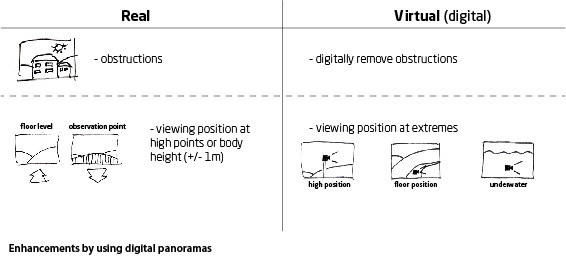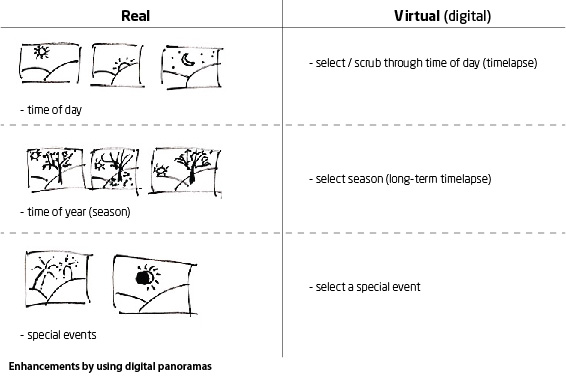4. October 2010
Beyond Geolimitation
 From the insights gathered I started a comparison between real viewpoints and the possibilities of Virtual or digital technologies.
The first aspect i looked at was location. Here there are 2 advantages of the virtual imaging compared to real life.
Firstly in many viewpoints there are unwanted obstructions to the view. In digital imaging these can be removed or certain parts of the image enhanced.
Secondly, we are limited to reachable spots for observation and are usually limited by our body height. In digital imaging, the images can be taken at extreme positions, for example using a high pole, extreme low positions (frog eye view) or even underwater.
From the insights gathered I started a comparison between real viewpoints and the possibilities of Virtual or digital technologies.
The first aspect i looked at was location. Here there are 2 advantages of the virtual imaging compared to real life.
Firstly in many viewpoints there are unwanted obstructions to the view. In digital imaging these can be removed or certain parts of the image enhanced.
Secondly, we are limited to reachable spots for observation and are usually limited by our body height. In digital imaging, the images can be taken at extreme positions, for example using a high pole, extreme low positions (frog eye view) or even underwater.
Transcending Time
 Using the starting point of navigation between spots being about distance and time, I also started looking at time as a potential factor. As 360 degree images are usually still photos there are some limitations, but also interesting possibilities.
A viewing point can be viewed at certain times of the day, but usually not over extended periods over the whole day, the year or even longer periods. Using digital technolgies (time-lapse) the user could scrub through time and view a certain spot at different times.
Using the starting point of navigation between spots being about distance and time, I also started looking at time as a potential factor. As 360 degree images are usually still photos there are some limitations, but also interesting possibilities.
A viewing point can be viewed at certain times of the day, but usually not over extended periods over the whole day, the year or even longer periods. Using digital technolgies (time-lapse) the user could scrub through time and view a certain spot at different times.